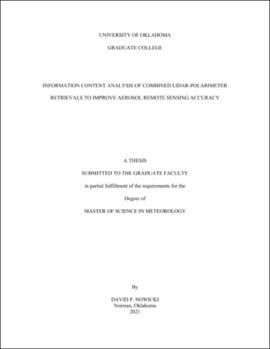| dc.contributor.advisor | Xu, Feng | |
| dc.contributor.author | Nowicki, David | |
| dc.date.accessioned | 2021-07-20T16:12:11Z | |
| dc.date.available | 2021-07-20T16:12:11Z | |
| dc.date.issued | 2021 | |
| dc.identifier.uri | https://hdl.handle.net/11244/330147 | |
| dc.description.abstract | Aerosols are small particles suspended in the atmosphere which affect global climate change via scattering and absorbing sunlight and serving as cloud condensation nuclei. Moreover, the prevalence of some anthropogenic and toxic aerosols has a direct adverse impact on public health. At present, aerosols remain the greatest source of uncertainty for radiative forcing. Though accurate characterization of spatially and temporally varying aerosols is difficult, two powerful remote sensing techniques, polarimetric and lidar measurements, have the complementary strengths of resolving column-effective and vertical distributions of aerosol properties, respectively. Vigorous development of these instruments has sparked our interest in 1) their collocation on ground-based, airborne, and space-borne platforms and 2) developing more efficient, versatile forward and inverse models that make use of combined lidar and polarimetric data to enhance aerosol remote sensing accuracy. In our effort to address target 2, the information content analysis (ICA) method is adopted in this study. It uses a priori information of speciated aerosol characteristics and various assumptions of measurement uncertainties as input. Combined with the use of a light scattering model and a radiative transfer model, lidar and polarimetric signals are simulated. The retrieval uncertainties of a suite of aerosol-related geophysical variables (GVs) are output by ICA, which allows us to explore the dependence of GV retrieval capabilities on a priori knowledge of aerosol properties and instrument accuracy. We analyze results to 1) check whether aerosol GV uncertainty thresholds established by NASA’s Aerosol and Cloud, Convection and Precipitation (ACCP) mission are met by different lidar and polarimetric instrument configurations and 2) identify a cost-effective, yet accurate, instrument combination for future missions. Five different methods are used to perturb a priori knowledge of state vector and measurement uncertainties across seven different lidar and/or polarimeter instrument configurations. Calculated GV uncertainties output by our model are compared to threshold GV retrieval uncertainties established by ACCP’s Science and Applications Traceability Matrix (SATM). Results show clear impact of a priori knowledge on retrieval capabilities as well as the importance of specific measurements to accurate retrievals of the GVs considered. Across results, the 2β 2α 1β_attn lidar and polarimeter (L6+POL) instrument combination consistently showed superior abilities of retrieving the GVs considered within SATM-prescribed uncertainty ranges. | en_US |
| dc.language | en_US | en_US |
| dc.rights | Attribution-ShareAlike 4.0 International | * |
| dc.rights.uri | https://creativecommons.org/licenses/by-sa/4.0/ | * |
| dc.subject | aerosols | en_US |
| dc.subject | remote sensing | en_US |
| dc.subject | polarimetry | en_US |
| dc.subject | information content analysis | en_US |
| dc.title | Information content analysis of combined lidar-polarimeter retrievals to improve aerosol remote sensing accuracy | en_US |
| dc.contributor.committeeMember | McFarquhar, Greg | |
| dc.contributor.committeeMember | Redemann, Jens | |
| dc.date.manuscript | 2021-07-19 | |
| dc.thesis.degree | Master of Science in Meteorology | en_US |
| ou.group | College of Atmospheric and Geographic Sciences::School of Meteorology | en_US |
| shareok.nativefileaccess | restricted | en_US |

